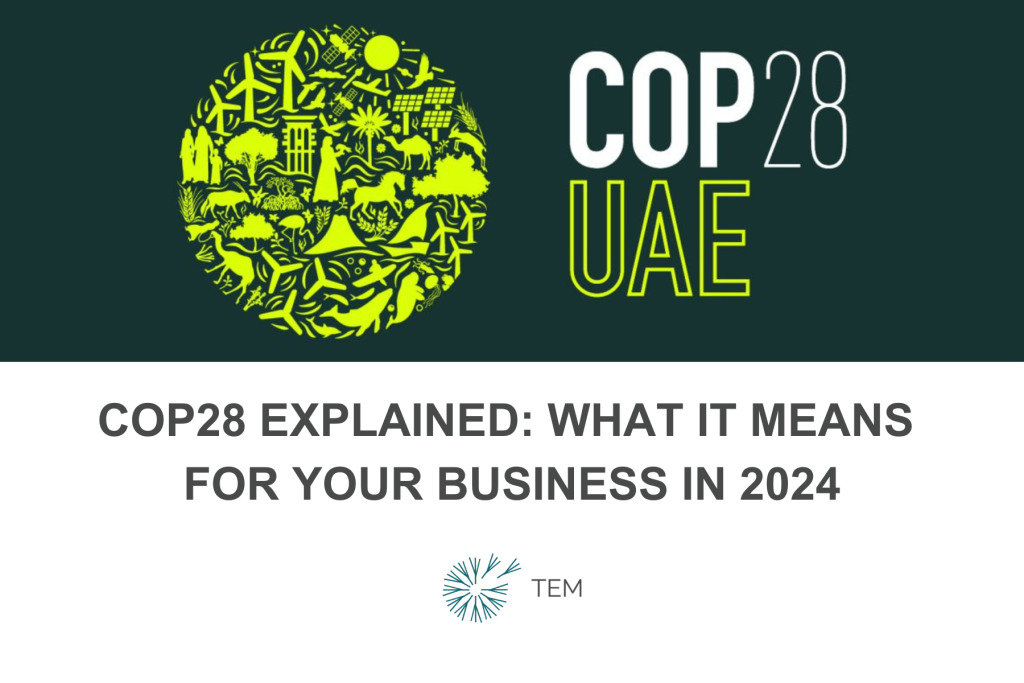COP28 explained: what it means for your business in 2024

With COP28 now behind us, what does it mean for the carbon market and your business in 2024? Here TEM’s David Tow, Bjorn Everts and Georgia Cox unpack the top 3 key outcomes and key developments, and what lies ahead for climate action in 2024 following COP.
The recent COP28 international climate conference, held in Dubai, which TEM’s Managing Director, Asia Pacific, David Tow, and Head of Carbon Solutions, Bjorn Everts, attended, had many working in carbon markets on the edge of our seats. One of the major outcomes of the conference was a global agreement to transition away from fossil fuels in a just and equitable manner, which is a pivotal step in the path to net zero emissions.
At COP, international climate negotiators also strove to strike an agreement in the way international carbon markets are governed. Their task was not an easy one: they needed to strike a delicate balance between an international carbon market system with a strong foundation in integrity, and one that is rapidly scalable. With negotiations continuing later in 2024, progress on both integrity and scalability of the market has continued well after the conclusion of the conference, paving the way for continued corporate climate action into the second half of the decade.
This year’s World Economic Forum in Davos – held last week – also built on many of the themes that were debated in Dubai. This included ‘A Long-Term Strategy for Climate, Nature and Energy’ being a key theme at Davos.
Snapshot of what happened at COP for carbon markets
The mammoth conference returned mixed results: although the pace of progress in the formal negotiations was not ideal, we also saw a raft of encouraging new developments to facilitate investment in carbon projects around the world under Article 6.2 of the Paris Agreement. This included:
- Memorandum of understandings (MOUs) signed by Singapore with Fiji, Senegal, Rwanda and Costa Rica
- An Implementation Agreement between Papua New Guinea (PNG) and Singapore (explained further below)
- Vietnam to launch a domestic compliance market, piloting from next year, and
- Many other national market frameworks developed, including in Africa, Europe and the Middle East.
All of this points to the continued evolution of carbon markets globally and key international leaders rounded out the year at COP by underscoring the credibility and necessity of high-integrity carbon market mechanisms: John Kerry, Tony Blair, Ursula von der Leyen – to name a few – all championed carbon markets. To supplement this, key standards bodies in the carbon market came together to agree – for the first time – on the role of carbon offsets in corporate decarbonisation plans (more on this below).
Top 3 key outcomes and developments
1. Increased impetus on multi-lateral and bi-lateral trade agreements
The Paris Agreement paves the way for carbon markets to be used to meet national emissions targets via two means:
- a decentralised, flexible approach (Article 6.2), and
- a centralised carbon market administered by the United Nations (Article 6.4).
Negotiations on Article 6.4 at COP were slower than expected, meaning the centralised market mechanism is not expected to be operational until at least 2026. This places more impetus on Article 6.2 in the meantime to spur critical investment in decarbonisation projects.
In practice, this means that countries are forging partnerships to generate carbon projects in areas of least-cost abatement. Closest to home, the new Implementation Agreement between PNG and Singapore sets out a legally binding framework for Singapore to purchase units from PNG. The units will count towards Singapore’s decarbonisation efforts while spurring investment in PNG. Seven per cent of the units generated will be automatically cancelled, to further enhance global decarbonisation and support PNG’s ability to adapt to climate change. Units traded between the two countries will be eligible to be used for things such as international aviation offsetting, towards meeting compliance under Singapore’s carbon tax, and for the Singaporean Government itself to meet its international decarbonisation commitments.
TEM is at the forefront of these developments, working closely with both our Singaporean and PNG partners. The Singaporean Government has issued a whitelist of eligible project types on 19 December 2023 and it is expected that TEM’s PNG Grouped Improved Cookstove Project will be the first eligible project under the Singapore-PNG agreement.
2. Collaboration between standard setters to simplify and drive ambition for corporate decarbonisation
During COP a number of high-profile decarbonisation standards and initiatives came together to create cohesive guidance on corporate decarbonisation. These organisations included:
- Voluntary Carbon Markets Integrity Initiative (VCMI)
- Integrity Council for the Voluntary Carbon Markets (IC-VCM)
- We Mean Business Coalition (WMB)
- Climate Disclosure Project (CDP)
- Science Based Targets initiative (SBTi)
- Greenhouse Gas Protocol (GHG Protocol).
This guidance is designed to support businesses in understanding how they can transition to a sustainable future, which frameworks to follow and how to talk about their own contributions to global decarbonisation. They said this was done for “the express goal of helping corporates understand who they should work with in two main activities that are central to climate transitions”. They said this was:
- “firstly, decarbonising their operations and value chains”
- “secondly, addressing remaining emissions with high-integrity carbon credits”.
The guidance articulates that after measuring and reporting on emissions, companies should set science-based decarbonisation targets, have them validated, and reduce emissions as much as possible at the source. Concurrently, companies should offset any residual emissions that cannot be immediately reduced.
The short explainer video they produced about how it will work says: “companies should take responsibility for all of their remaining emissions using verified carbon credits as part of their pathway to net zero.”
The consensus agreement from these groups again highlights the critical role of high integrity carbon credits in corporate transition plans and provides much-needed clarity to corporates.
- Watch their short explainer video
3. Agreement between voluntary standards to improve and align carbon projects
Also at COP, we saw a landmark agreement by six key carbon project certifiers to streamline their approaches to carbon projects. Independent carbon crediting programs Verra, Gold Standard, ART Trees, CAR, ACR and the GCC were part of the agreement, representing the majority of carbon projects internationally.
They will aim to: harmonise their quantification and accounting of carbon projects, insure against reversals, streamline the technical aspects of projects, and strengthen stakeholder protections and redress mechanisms.
These are all welcome developments for the industry and will serve to attract increased investment in climate projects and help with corporate engagement.
What lies ahead after COP?
The renewed commitment and enthusiasm for the carbon market at COP and new initiatives launched at the event provide important momentum for carbon markets and signal a positive year ahead for the market. As the Voluntary Carbon Markets Initiative (VCMI) said: “If 2023 was a year of progress for the market, 2024 is the year of action and growth.”
Work will continue on standardising and streamlining the market on both the project side and corporate claims side. Multilateral agreements to facilitate investment in projects will also continue to proliferate, and TEM looks forward to playing an ongoing role in this in the APAC region.
In November this year, COP29 will be held in Azerbaijan, which will continue the important negotiations on the rules underpinning Article 6. We can also expect to see more exciting commitments by corporates and countries alike.
Beyond this year, 2025 will be a pivotal year for global decarbonisation ambition: under the Paris Agreement’s ‘ratchet mechanism’, countries are required to submit revised national targets (‘NDCs’) out to 2035 in 2025. This means that countries, including Australia, will need to ensure their decarbonisation trajectories are aligned with the latest available science to limit warming to 2 degrees Celsius above pre-industrial levels. Increasingly, in order to manage risk, many corporates will also be seeking to align their commitments with these trajectories.
We look forward to watching the progress over the years ahead, for example seeing more companies implementing decarbonisation plans aligned with the new guidance from the VCMI and its peers, in which they say the use of carbon credits is a key aspect.
Now more than ever, carbon credits remain an important tool for supporting decarbonisation today, alongside reducing emissions and channelling critical finance to much-needed climate solutions. These projects reduce carbon from the atmosphere and deliver other important additional benefits, such as increases in biodiversity and health and economic outcomes for local communities.
Disclaimer
This information has been prepared by Tasman Environmental Markets Australia Pty Ltd (TEM), a corporate authorised representative (ABN 97 659 245 011, CAR 001297708) of TEM Financial Services Pty Limited (ABN 58 142 268 479, AFSL 430036). It provides general advice only and does not constitute personal financial advice or take into account your objectives, financial situation or needs. Although we believe that the material is correct, no warranty of accuracy, reliability or completeness is given, except for liability under statute which can’t be excluded. Before making an investment decision, you should first consider if the information is appropriate for your circumstances, and seek professional financial advice. Please note past performance is not a guarantee of future performance.



